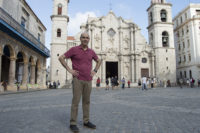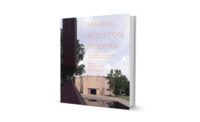Very little survives from the built work of Konrad Wachsmann, who was born in 1901 in Frankfurt an der Oder and died in Los Angeles in 1980. His German beginnings in architecture were in wood construction, as he worked for Christoph & Unmack, a firm engaged in prefabrication, and built Albert Einstein’s weekend house in Caputh, Germany, in 1929. During the Second World War, after he emigrated to the U.S., he designed the Packaged House System, consisting of assembled factory-made panels, held together by his extremely ingenious “wedge connector,” though the system turned out to be a commercial failure. But several of the modest, boxy houses still dot the Los Angeles landscape.
Dropping wood for metal, Wachsmann hit the headlines in 1954 with a giant cantilevered hangar for the U.S. Air Force’s strategic bombers. Designed at IIT in dialogue with Mies van der Rohe, it was a forest of tubular trusses joined by other imaginative nodes. Floating high above the ground, this expansive structure became the main attraction of his carefully laid-out book The Turning Point of Building, published in 1959 in Germany, a bible for European radical architects beginning with Yona Friedman, and which mesmerized me during my student years in the late 1960s. It assembled a seductive collection of images ranging from the Crystal Palace to Wachsmann’s own Mobilar building system. In parallel with the making of this book, he taught seminars from Germany to Austria, Israel, and Japan, where his influence on the young Metabolists was significant.
Now Mark Wigley, in his minimalist volume based on discoveries he made in Wachsmann’s archive at Berlin’s Academy of Fine Arts, discusses the most elusive of the architect’s designs—the “Twisting-net.” In it, the differentiation between the nodes and the struts of the structure is dissolved, as shown in the Piranesian drawings he produced with his Chicago IIT students and exhibited for decades in a wide range of venues. Attention is also devoted to a vast horizontal cable structure conceived in the 1960s for the Civic Center of California City, a settlement begun in the Mojave Desert by developer Nathan Mendelsohn, which would have largely operated through television.
Wigley’s pocket-size book unveils this hitherto repressed face of Wachsmann, who shunned both wood and steel in order to operate in an immaterial world of visual and numeric data. In the early 1970s, television was invested by him with multiple potential virtues, as the vector for an interconnected society. Attracted by screens and computers, Wachsmann imagined new ways of transmitting energy and creating ever more ambitious spatial structures, for instance in his 1974 “Manifest for the Evolution of Assembling the Artificial Human Environment between Time and Space,” unearthed by Wigley. Wachsmann explored these ideas at the Division of Building Research he had created at the University of Southern California in 1966 with the blessing of Mies, while conceiving a television series about the environment that would allow citizen participation—and dissent. Wigley’s elegant and witty work considers the German-American’s research strategy and its reception, precisely inserted in the networks of Cold War modernism—from émigrés to emerging designers and theorists— subtly sculpting the portrait of a man he sees as a “wireless architect, or, more precisely, a post-architect.”








Post a comment to this article
Report Abusive Comment